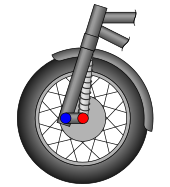Short swing arm
With short swing arm or short arm swing arm one designates a type of front wheel guidance on motorcycles .
The first short turns are known from FN (1904). In contrast to the long arm swing arm , the pivot point is within the wheel diameter. Short swing arms have the disadvantage of the relatively short spring travel due to the design, which is in the range below 100 mm and therefore cannot compensate for larger unevenness in the road. With a "half-length swing arm" u. a. With the Hercules K 125 BW model, attempts were made to compensate for this disadvantage.
A distinction is made between the types with regard to the pivot point in the direction of travel in front of or behind the wheel axle:
- Pulled short swing arms (with / without auxiliary fork)
- Pushed short swing arms (with / without auxiliary fork)
Pulled short turns
The first drawn short swing arm with auxiliary fork and leaf springs is known from the Belgian company Minerva (1905). The drawn short swing arm with auxiliary fork and leaf springs was built in larger numbers by Indian (1910–1946) and BMW (1923–1936) (see leaf spring fork ). With the Vespa 98 model (1946), Vespa introduced the drawn single-arm short swing arm for scooters. To this day the Vespa and many other scooters are built with the drawn short swing arm as front wheel guidance.
Pushed short turns
The first pushed short swing arm ( with auxiliary fork) was introduced in the FN -Four (1904). 1908 "Teller Cushion-fork" was (a pushed short rocker with auxiliary fork) in Harley-Davidson presented at the 1929 Harley-Davidson introduced Springer fork remained to 1953 in the sales program. Brough Superior called the pushed short swing arm with auxiliary fork, which was built from 1924, "Castle fork". The pushed short swing arm (without auxiliary fork) was introduced in 1949 at NSU Motorenwerke for the NSU Fox model. The pushed short swing arm is no longer offered on current motorcycles.
Advantages and disadvantages
The advantages are the simple, inexpensive construction, as well as the possibility of accommodating the swing arm in a space-saving manner, which is why it is still used today in motor scooters with small running wheels.
The biggest disadvantage is the very limited travel. Short front swing arms are usually in individual parts, i. H. designed in two parts as a short rocker arm and only connected by screwing the front wheel thru axle. This can lead to a certain weakening and sometimes the danger of one-sided compression and thus a misalignment between the front and rear wheels, i.e. This means that as a result of one-sided transverse load, the front wheel is at a different angle to the vertical than the rear wheel, as there is no reinforcement around the front wheel "around the rear" due to the lack of a one-piece swing arm. In technical terms, the torsional stiffness around the longitudinal axis is considerably better with a one-piece welded pipe construction ("U") than with two individual short rocker arms ("II"). There are additional disadvantages with drawn short swing arms like the BMW R 42 . With this front wheel guidance, immersion increases when braking, while when the front wheel swing arm is pushed, the dynamic wheel load shift is somewhat compensated for by the righting braking torque - the front fork of an NSU Quickly even lifts up on the short lever when braking.
photos
drawn one-armed short swing arm of an early ( Vespa )
View of the one-armed short swing arm with shock absorber of a Vespa 150 Sprint .
pushed short swing arm with auxiliary fork ( Harley-Davidson model 4)
References and comments
- ^ Helmut Werner Bönsch: Progressive motorcycle technology . Motorbuch Verlag Stuttgart, 1985, ISBN 3-613-01054-2 . P. 224.
- ↑ S. Ewald: Encyclopedia of the motorcycle . Bechtermünz Verlag, Augsburg 1996, ISBN 3-86047-142-2 , p. 178.
- ^ Helmut Werner Bönsch: Progressive motorcycle technology . Motorbuch Verlag Stuttgart, 1985, ISBN 3-613-01054-2 . P. 225.
- ^ Oskar Koch: The current state of motorcycles. In: Polytechnisches Journal . 321, 1906, pp. 294-298.




